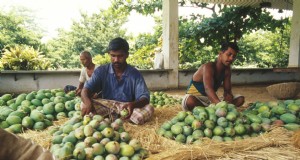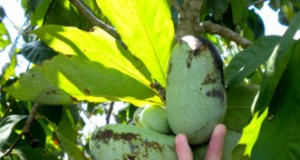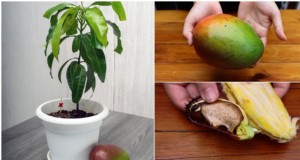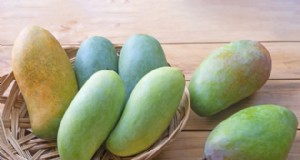Introdução e importância
A manga (Mangifera indica L Family Anacardiaceae) é a segunda maior cultura de frutas no Paquistão. Atualmente é cultivada em uma área de 93,42 mil hectares com produção de 915,7 mil toneladas Tabela-1. A área de cultivo de manga aumentou, mas o aumento da produção é comparativamente lento. Os principais distritos de cultivo de manga na província de Punjab são Multan, Bahawalpur, Muzzaffargarh e Rahim yar Khan. Na província de Sindh é cultivado principalmente em Mir pur Khas, Hyderabad e Thatta na província de NWFP é cultivada em Peshawar e Mardan. O clima de Sindh fica mais quente cerca de um mês antes do Punjab, o que deu à província o privilégio de cultivar variedades precoces de manga. Subseqüentemente, uma nova tendência de cultivo de variedades tardias em Punjab ganhou grande popularidade, o que estendeu o período de mercado e aumentou o excedente exportável.
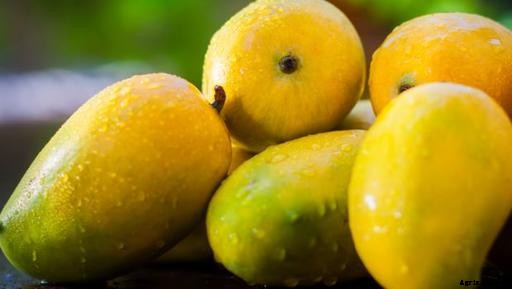
Esta deliciosa fruta é nutricionalmente superior, fonte de várias vitaminas e minerais. O Paquistão produz 5,86 por cento das mangas do mundo, sendo o terceiro maior produtor. Sua exportação está progredindo, resultando em receitas substanciais em moeda estrangeira. A exportação de manga, incluindo o Oriente Médio, também encontrou seu caminho para o Reino Unido e outros mercados europeus. Acredita-se que a demanda aumentaria para até 50 por cento, dado o impulso certo e expandindo a exportação para a Alemanha, Japão, China e Hong Kong.
Clima e Solo
As condições ecológicas adequadas para o cultivo da manga são:
- Elevações variando de 200 a 300 metros.
- A faixa de temperatura adequada é de 15 a 40oC. Baixas temperaturas são extremamente prejudiciais. Geadas e ventos quentes causam grandes danos às árvores. As plantas jovens precisam de proteção contra geadas e ventos quentes.
- Um clima quente e úmido é adequado. Em áreas com chuvas fortes, a qualidade da fruta pode ser afetada.
- A manga pode ser cultivada em uma ampla variedade de solos, mas bem drenada, solos profundos e férteis são os mais adequados. Solo afetado pelo sal não é bom para o seu cultivo.
Propagação:
- A propagação é feita por vários meios de enxertia em mudas locais.
- Idade adequada do viveiro para transplante de 1,5 a 2,0 anos
- Tempo para o transplante:
- Na primavera:fevereiro / março
- No outono:setembro / outubro
- Tempo para iniciar o rolamento:4-5 anos
- Tempo para carga total:6-7 anos
- Vida econômica normal do rolamento:30-50 anos
- Época de floração:fevereiro / março
Principais variedades comerciais:
- Sindh:Sindhri, Gulabkhas, Swarnarice, Baganpalli, Colecionador, Neelum
- Punjab:Malda, Langra, Aman Duseri, Anwar Ratol, Samer Bahisht, Fajri Kalan e Sensation.
- NWFP:Lengra e Samer Bahisht
- Baluchistão:Sindhri e Banganpalli
Tecnologia de produção:
- Demanda Anual de Água da Colheita:500-750 mm
- Intervalos de irrigação:
- Plantas jovens:7 dias
- Árvores maduras no inverno:15-20 dias
- Árvores maduras no verão:8 a 10 dias
- Aplicar estrume de quintal na proporção de 10-30 kg por planta jovem e 80 a 100 kg por árvore adulta.
- Aplique SSP de 3-4 kg, 2-3 kg de sulfato de potássio e 2-3 kg de uréia antes da floração (dezembro a janeiro).
- Aplicar mais 2-3 kg de uréia após o endurecimento da fruta em duas doses iguais (março / abril).
Poda
A manga geralmente assume uma forma de cúpula graciosa sombreando o tronco principal. No entanto, nenhuma poda é praticada, anualmente após a colheita de frutas doente, seco, galhos quebrados e aqueles que tocam o solo devem ser podados. Para rejuvenescer o pomar a cada 3-4 anos é aconselhável retirar 15-20% da madeira velha.
Colheita
A colheita deve ser feita quando o fruto estiver totalmente desenvolvido e maduro. A queda natural da fruta é a principal indicação de que a fruta está pronta para a colheita. Diferentes variedades em diferentes áreas maduras em épocas diferentes. Em Sindh, variedades de manga começam a amadurecer de maio a junho. No Punjab, o amadurecimento começa em junho e continua até meados de agosto. Em NWFP, a colheita é tardia, o que ajuda a estender o período de disponibilidade das mangas. Os rendimentos esperados variam de 40 a 100 kg por árvore.
Doenças na manga:
Oídio
Os sintomas podem ser notados na inflorescência, haste da inflorescência, folhas e frutos jovens. Os sintomas característicos da doença são o crescimento pulverulento superficial branco do fungo nessas partes. As flores eficazes podem cair prematuramente e os frutos jovens podem permanecer na árvore até atingirem o tamanho de uma bola de gude e então cair prematuramente. A queda de flores infectadas não fertilizadas e frutos jovens leva a sérias perdas de safra (20-80%).
Ao controle:-
- A poda de folhas doentes e panículas malformadas reduz os inóculos primários.
- Três pulverizações de fungicidas sistêmicos durante a época de floração são recomendadas em intervalos de 12-15 dias.
- A 1ª pulverização é recomendada quando há 25% das flores abrindo.
Antracnose / Blossom Blight
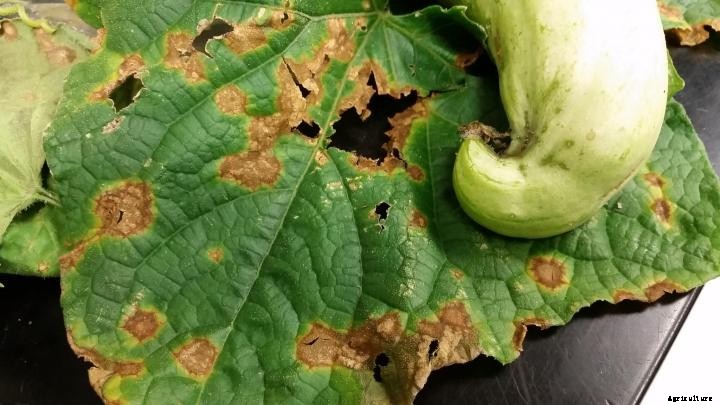
A antracnose se manifesta em diferentes partes da mangueira. Na inflorescência, os primeiros sintomas da doença são a produção de manchas marrom-pretas nos pedúnculos e nas flores. Pequenos pontos pretos aparecem nas panículas e flores abertas, que gradualmente aumentam e causam a morte das flores. As flores infectadas caem, deixando mais pontas de persistência nos pedúnculos, isso leva a sérias perdas de safra (10-90%) .95-97% R.H.Excessivo em nitrogênio.
Ao controle:-
- Folhas doentes, flores, galhos e frutas que estão no chão do pomar devem ser coletados e todos os galhos infectados da árvore devem ser podados e queimados.
- A infecção de flores pode ser controlada de forma eficaz por duas a três pulverizações de fungicidas de contato ou sistêmicos durante a primavera, com intervalos de 12 a 15 dias.
Malformação manga
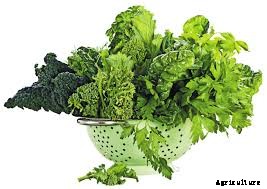
A malformação é uma séria ameaça às áreas de cultivo de manga do Paquistão, pois causa perdas de safra de até 70%. Descobertas recentes demonstraram que a doença pode ser de origem fúngica. Dois tipos distintos de sintomas descritos pelos trabalhadores são malformação vegetativa (MV) e malformação floral (MF). A malformação vegetativa é mais pronunciada em mudas jovens, bem como em árvores de mudas, do que nas plantas enxertadas. As mudas afetadas desenvolveram ramos vegetativos excessivos, que são de crescimento limitado, inchados e com internódios muito curtos.
A malformação da inflorescência (MF) é uma doença da inflorescência. Os sintomas mais característicos de (MF) são a redução e compactação dos internódios, dando à malformação uma aparência de vassoura. Material de enxerto infectado e feridas
Ao controle :-
Atualmente, nenhuma medida de controle definitiva para a malformação da manga pode ser defendida. No entanto, o seguinte pode reduzir a incidência de malformações
- É aconselhável evitar galhos de mudas de árvores com inflorescências malformadas para propagação.
- Somente mudas certificadas devem ser usadas para propagação.
- Assim que os sintomas da doença forem bem expressos, os terminais afetados devem ser podados junto com a porção contígua de 15-20 cm aparentemente sã e queimados.
Doenças das folhas:

A planta de manga é mais ou menos propensa a várias doenças foliares mencionadas abaixo, mas as mais importantes são discutidas em detalhes:
- Antracnose
- Sarna
- Praga de Phoma
- Manchas cinzentas
- Mancha de Alternaria
- Cancro bacteriano
Antracnose
Os sintomas característicos aparecem como manchas ovais ou irregulares de marrom a marrom-escuro de vários tamanhos espalhadas por toda a superfície da folha. Sob condições úmidas, o fungo cresce rapidamente. As folhas novas são mais propensas a atrair do que as mais velhas. O ataque de insetos pode facilitar a entrada do patógeno, resultando em grande incidência de doenças.
Ao controle:-
A infecção foliar pode ser controlada por pulverizações de fungicidas à base de cobre durante a primavera e após a estação das monções.
Mancha de Alternaria
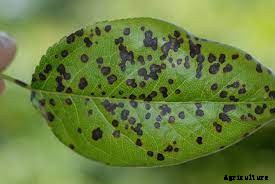
Os sintomas aparecem inicialmente como pequenos, manchas circulares acastanhadas na superfície das folhas. Mais tarde, alta concentração de manchas pretas marrons ocorre uniformemente sobre a lâmina foliar. Os sintomas são mais proeminentes na parte inferior das folhas. As folhas tenras são mais suscetíveis do que as maduras.
Ao controle:-
A doença pode ser controlada por um programa regular de pulverização em campo, incluindo fungicidas à base de cobre.
Canker bacteriano (Xanthomonas mangiferae)
Nas folhas, A pequena quantidade de água encharcada de lesões irregulares a angulares em relevo geralmente está aglomerada no ápice. Nas folhas novas, os halos são maiores e distintos, enquanto nas folhas mais velhas, eles são estreitos, podendo ser observados apenas contra a luz. Sob infecções graves, a folha fica amarela e cai 25-30 0C e> 90% R.H. Clima chuvoso
Ao controle:-
Inspeção regular de pomares, O saneamento básico e a certificação de mudas são recomendados como medidas preventivas contra a doença.
A pulverização de fungicidas à base de cobre foi considerada eficaz no controle do cancro bacteriano.
DOENÇAS DA FRUTA / DOENÇAS PÓS-COLHEITA
Antracnose
A doença é mais comum em frutos jovens e durante o trânsito e armazenamento. A infecção latente durante a fase de pré-colheita é responsável pela podridão pós-colheita. No armazenamento, manchas pretas são produzidas. Inicialmente as manchas são arredondadas, mas depois formam grandes manchas irregulares em todos os frutos, as manchas apresentam grandes fissuras profundas e o fungo penetra profundamente na fruta causando extenso apodrecimento.
Ao controle:-
As infecções pré-colheita podem ser tratadas pulverizando fungicidas à base de cobre após o término de chuvas intensas.
As infecções pós-colheita podem ser tratadas como pulverizações pré-colheita no campo para reduzir a infecção latente e tratamento da fruta com água quente / fungicidas após a colheita para erradicar a infecção latente que sobrou.
Podridão da extremidade do caule
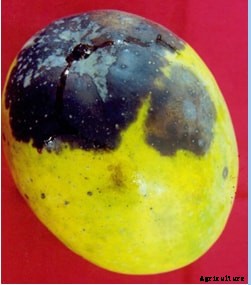
O fruto, durante o amadurecimento, torna-se repentinamente marrom a preto, tipicamente no final do caule. Dentro de dois três dias, a fruta inteira torna-se preta e a doença progride para baixo, envolvendo assim metade da área dos frutos. Embora o rubor de toda a fruta, muitas vezes, também sejam observadas rugas. A pele afetada permanece firme, mas a decomposição se instala na polpa abaixo e emite um odor desagradável.
Ao controle:-
- O manuseio rápido e adequado da fruta pode minimizar a incidência de doenças.
- Os frutos devem ser colhidos com caule de 10mm.
- Sprays pré-colheita de quaisquer fungicidas sistêmicos ou fungicidas à base de cobre reduzem a incidência de SER.
- A imersão pós-colheita da fruta em água quente suplementada com carbendazim ou tiofanato metílico (0,05%) por 15 minutos a 52 ± 1oC para controlar a doença.
DECLINAR TRANSTORNOS
Declínio é um termo geral e a manga é afetada por diferentes distúrbios do declínio, geralmente associados a estresses bióticos e abióticos.
-
- Morrer de volta
- Praga dos galhos
- Goma
- Rachadura de casca
- Descamação da casca
- Murchando
- Síndrome de Morte Súbita de Manga (MSDS)
Os distúrbios importantes do declínio da manga são descritos abaixo:
Morrer de volta
A doença é perceptível ao longo do ano, mas é mais evidente durante outubro e novembro. É caracterizada pelo ressecamento dos ramos de cima para baixo, especialmente nas árvores mais velhas, seguido pelo ressecamento das folhas, o que dá uma aparência de queimadura. As folhas superiores perdem a cor e secam gradualmente. A secagem de toda a folha é acompanhada pelo enrolamento da margem para cima. Essas folhas murcham, caem dentro de um mês, deixando todos os ramos enrugados expostos, que é o sintoma característico do estágio avançado da doença.
Seca, dor forte, Temperatura alta, árvores fracas, queimadura do sol, alta umidade, deficiência nutricional e danos físicos.
Ao controle:-
- A poda dos galhos afetados (3 '' abaixo do local da infecção) seguida pela pulverização de fungicidas à base de cobre é o método mais eficaz para o controle da doença.
- Em casos graves, a correção do solo com a remoção de solo de até 23 centímetros de profundidade sob a copa da árvore doente e reenchimento com o lodo do canal, doses recomendadas de fertilizantes químicos e FYM com poda dos galhos afetados seguida por três pulverizações consecutivas de fungicidas à base de cobre em intervalos de 15 dias também são recomendadas.
Praga dos galhos
A doença produz áreas necróticas pretas alongadas nos galhos. As folhas caem lentamente durante a subida e, por fim, caem. Os ramos muito jovens começam a secar da ponta para baixo. Lesões, Ataque de inseto, planta fraca de alta temperatura, estresse hídrico, geada e danos físicos.
Ao controle:-
Os galhos doentes que estão no chão do pomar devem ser coletados e todos os galhos infectados da árvore devem ser podados e queimados.
As pulverizações foliares de fungicidas à base de cobre refletem um bom controle.
Goma
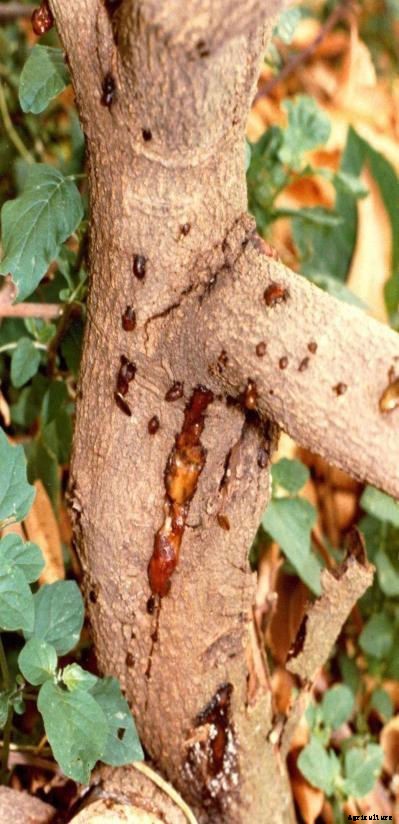
Cerca de 30-40% das mangueiras jovens são afetadas pela gomose, especialmente quando a mangueira é plantada em solo arenoso, mas sua prevalência também foi observada em outros solos de cultivo de manga. A doença é caracterizada pela presença de exsudação abundante de goma na superfície da madeira afetada, casca do tronco e também em galhos maiores, mas mais comum em galhos de fissura. Em casos graves, gotas de goma gotejam no caule e a casca torna-se marrom-escura com rachaduras longitudinais.
Ao controle:-
- A doença pode ser controlada com pulverizações regulares de fungicidas à base de cobre.
- A casca / porção doente deve ser removida, limpos e cobertos com pasta de fungicidas à base de cobre.
- A aplicação de sulfato de cobre 500g no solo arenoso ao redor do tronco da árvore também é defendida.
Cascas estalando
A fissuração da casca é caracterizada pelo desenvolvimento de fissuras longitudinais profundas. O enraizamento não está associado às rachaduras, mas a madeira subjacente apresenta-se severamente furada. Bolsos de gengiva também são notados junto com as rachaduras. Mais tarde, a casca é seca e arrancada, resultando em efeitos de anelamento, amarelecimento e queda das folhas seguido pela morte dos ramos.
Ao controle:-
- Pulverização de oxicloreto de cobre.
- Aplicação de sulfato de cobre no solo.
- Remoção da casca morta e colagem da pasta bordeaux.
Podridão de raiz
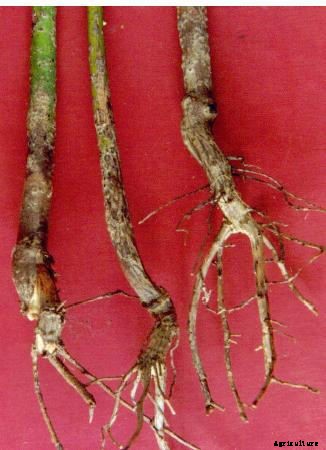
A infecção ocorre em / ou abaixo do nível do solo, em manchas circulares a irregulares com meias d'água. Essas manchas aumentam e, por fim, envolvem toda a base do caule. Por causa do apodrecimento, os tecidos doentes ficam moles, marrom escuro ou preto.
Ao controle:-
Tratamento do solo com Tiofanato Metílico, carbendazim ou oxicloreto de cobre @ 2g / ft2 é recomendado.
Durante o período de crescimento, qualquer fungicida à base de cobre deve ser pulverizado nas plantas.
Síndrome de Morte Súbita de Manga
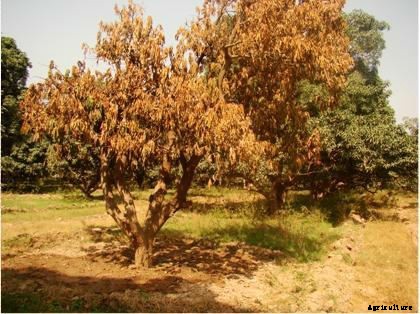
Mango sudden death syndrome (MSDS) has become an important disease in Pakistan since 1997 which is closely associated with infections by Ceratocystis fimbriata possibly in concert with Botryosphaericaceous fungi like Lasiodiplodia theobromae. Improper irrigation and root injuries have been found as major predisposing factors for this disease. Affected mango trees have wilting symptoms. Cankers may develop over areas of vascular discoloration and the cankers my exude gum from the stem. Wilted leaves typically become dry and curled rather suddenly but remain attached to the tree for several weeks. It is a serious disease and aggravating day by day by which apparently healthy looking mango plants die within days and it is destroying the Precious wealth of Pakistan. Up till now 4-12% mortality rate has been observed in different mango growing areas of Pakistan.
Control :-
Early detection is very important for the proper management of this disease. For this purpose scientists have divided this syndrome into five categories (0-5 stages) with collective wisdom. The detailed pictorial presentation of each stage has been developed for the guideline of mango growers under ASLP project. However some important points are being discussed over here.
- 0 stage =No Disease
- 1 &2 stage =Less than 50 % disease severity
- 3 &4 stage =More than 50 % disease severity
- 5 stage =Dead &totally wilted plants
Uproot the plants showing 3, 4 &5 stages immediately and treat the soil with fungicide. Soil solarization of this area is also recommended.
Treat the plants falling in 1 &2 stages with the following way:
- Scratching of the infected portion followed by three pasting of Thiophanate methyl or Carbendazim @ 250kg/liter with one week interval
- These fungicides may be injected thrice with the same interval @ 5g/20ml/hole with the formation of 4 holes on the main trunk of the tree having ½ inch dia, 4-6 inch deep at 45oC. These holes should be made at 1 foot height starting from the ground level and covering the whole girth. Optimize the soil conditions of the diseased plants through the application of FYM phosphorus, potash and gypsum (if required).
- Minimize the plant requirements through de-blossoming, timing of fruit, pruning and foliar spray of micronutrients.
- The following recommendations are given for the plants showing no diseases (0 stages).
- Do proper irrigation whenever it is required.
- Keep the water 3 to 4 ft away from the stem by making “watt” or slope.
- The area under canopy should be at field level.
- Avoid intercropping in mango orchards.
- Properly control bark beetle and termite infestation.
- Follow departmental recommendation for fertilizer application.
- Organic matter should be added in the form of FYM or green manure preferably every year.
- Always avoid hoeing and ploughing in mango orchards.
- Spray of Thiophanate methyl or Carbendazim @ 2g/liter must be included in spray schedule and it should be done in a way covering the whole area of the tree up to ground level.
- Injections of these fungicides for healthy plants as preventive measure are also advocated.
- The plants showing any type of decline disorders other than MSDS may be treated accordingly.
Insect Pests in Mango:
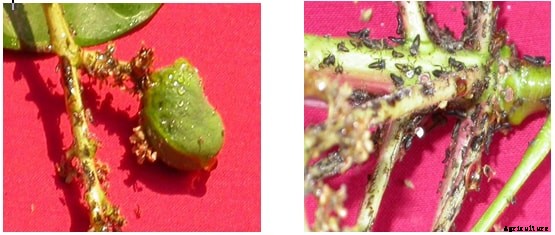
Hopper
Symptoms:
The wedges shaped Nymphs and adult insects puncture and suck sap of tender parts, reducing vigour of plants and particularly destroying the inflorescence and causing fruit drop. Heavy puncturing and continuous draining of sap causes curling and drying of infested tissue. They also damage the crop by excreting a sweet sticky substance facilitates the development of sooty mould .
- Avoid dense plantings, maintained open canopy; prune overcrowded overlapping branches after rainy season.
- Orchards should be kept clean by regular ploughing and removal of weeds.
- Conservation of bio control agents like predator, Mallada boninensis, Chrysopa lacciperda, egg parasite, Polynema spp. Gonatocerus sp. Tetrastichus sp. and fungus, Verticillium lecanii.
- Spraying of 0.2% Nimbicidin or Azadirachtin 3000 ppm@2m/l at initial stage of hopper population.
- Spray Lambda cyhalothrin 5% EC@ 0.5 ml or imidacloprid 200 SL @ 0.25 ml/l or Thiamethaxam (0.05%) or propanophos (0.05%). First spray should be done at early stage of panicle formation if hopper population, is more than 5-10 panicle, second spray at full length stage of panicle and the third spray after fruit setting (at pea size).
- Chemical spray is to be minimized and should be need based.
- A rational rotation of insecticide is desirable to counteract the tendency of pest to develop field resistance.
Mealy bug
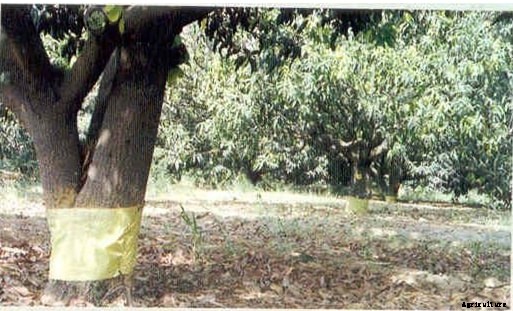
Symptoms:
The adult bugs are covered with whitish powder and colonize between bark of tree trunk, young shoots and panicles. The nymphs’ ascent the trees and settle on inflorescence causing flower drop, affecting fruit set. They also excrete honey dew, a sticky substance, which facilitates development of sooty mould).
Gestão
- Flooding of orchard with water in the month of October kill the eggs.
- Ploughing of orchard in November.
- Raking of soil around tree trunk to expose the eggs to natural enemies and sun, removal of weeds and mixing with chlorpyriphos dust 1.5% @250 g/ tree during January.
- After mud plastering, banding of tree trunk with alkathene (400 gauge), 25 cm wide sheets should be fastened to the free trunk with the help of sutli, 30 cm above ground level and application of Beauveria bassiana product (2g/liter 1×107 spores / ml) or 5% NSKE in last week of January around tree
- trunk.
- Conservation of bio control agents, Beauveria bassiana, predators, Menochilus sexmaculatus, Rodolia fumida and Sumnius renardi.
- Releasing 10-15 grubs of cocinellid predator, C. montrozieri per tree.
- If nymphs ascended on tree spray carbosulfan (0.05%) or Dimethoate (0.04%)
Inflorescence / leaf/ twig midge
Symptoms:The larvae tunnel the axis of inflorescence and destroy it completely. Damage by E. indica causes bending and drying of the inflorescences. Second attacks starts at fruit setting as young maggots bore into these tender fruits which slowly turn yellow and finally drop. Third attack is on tender ‘new leaves encircling inflorescence. The most damaging one is first attack in which the entire inflorescence is destroyed. The inflorescence shows stunted growth and its axis bends, at the entrance point of larva (Fig 7 &8).
Midge Management
- Collection and disposal of infested panicles leaves and twigs.
- Deep ploughing of orchard in October- November to expose pupae and diapausing larvae to sun’s heat which kills them.
- Monitoring of larval population on white paper in April/ May and apply chlopyriphos (1.5%) dust based on population.
- Spray dimethoate (0.05%) at bud burst stage.
Fruit flies
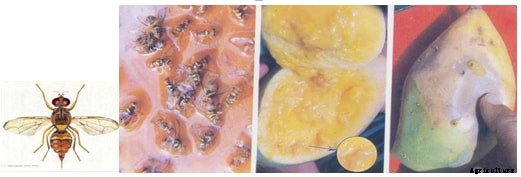
Symptoms:The female punctures outer wall of mature fruits with the help of its pointed ovipositor and insert eggs in small clusters inside mesocarp of mature fruits. On hatching, the maggots feed on fruit pulp and the infested fruits start rotting due to further secondary infection .
Gestão
- Prior to harvest (30-40 days) collect and dispose of infested and fallen fruits to prevent further, multiplication and carry-over of population.
- Ploughing of orchard during November-December to expose pupae to sun’s heat which kills them.
- Hanging of methyl eugenol wooden block traps soaked in ethanol, methyl eugenol and malathion (6:4:1) during fruiting period from April to August @10 traps/ ha tie them tightly at 3-5 feet above ground level.
- To control adult flies during severe infestation placing poison bait viz Protein hydrolysate +malathion 50 ml +200 ml molasses in 2 litres of water be sprayed adding an additional 18 liters of water to bait poison. Commencing at pre oviposition period and repeat at 15 days interval. Addition of 10 ml methyl eugenol in place of molasses is also recommended.
- Hot water treatment of fruit at 48 +_ 10 C for 60 min.
- Three weeks before harvesting, spray Deltamethrin 2.8 EC @ 0.5 ml/l + Azadiractin (3000 ppm) or 2 ml/l.
- Irradiation of fruits 400 G- rays using cobalt 60 to control fruit fly.
- If infestation is heavy, bait splash on the trunk only, once or twice at weekly interval is recommended. To prepare bait splash, mix 100 gm of jaggery in one litre of water and add 1 ml of Deltamethrin by using an old broom.
- Managing fruit flies also reduces anthracnose disease and prevents late fruit fall.
Leaf webber

Symptoms:Initially caterpillars feed on leaf surface gregariously by scrapping/Later they make web of tender shoots and leaves together and feed within. Several caterpillars may be found in a single webbed up cluster of leaves.
Gestão
- Pruning of overcrowded and overlapping branches.
- Mechanical removal of infested webs by leaf web removing device and burning them.
- Ploughing of orchard done earlier for mealy bug control checks its population.
- Two to three sprays commencing from last week of July with carbaryl (0.2%) or quinalphos (0.05%). This spay will also take care of mango psylla (Apsylla cistellata).
- The use of same chemical for every spray should be avoided.
Shoot gall psylla
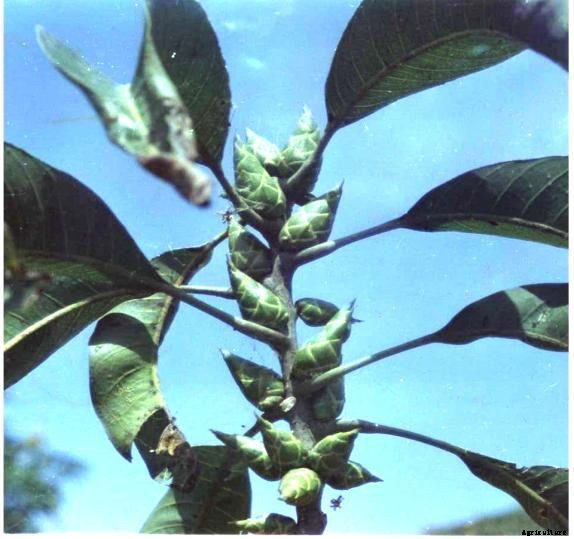
Symptoms:Nymphs emerge during August September and suck cell sap from adjacent buds. As a result of feeding, buds develop into hard conical green galls.The galls are usually seen during September-October. Consequently there is no flowering and fruit setting. Nymphs pass winter inside the galls.
Gestão
- Galls with nymphs should be collected and destroyed.
- Spray dimethoate (0.06%) or quinalphos (0.05%) at fortnightly interval starting from August.
- Spray 2, 4-D (150 ppm, i e 150 mg/ liter of water) during October whichopens the galls and nymphs come out and are killed with cold.
- New mango orchard in humid region need to be discouraged.
Stem-borer
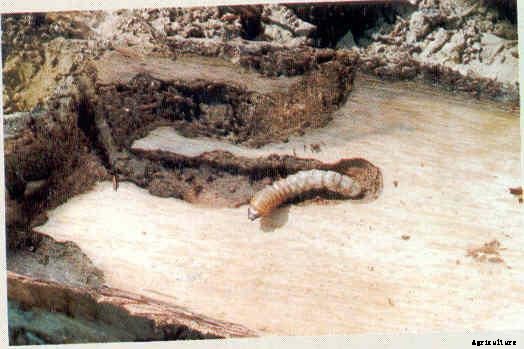
Symptoms:The damage is caused by grubs either to roots or stems. The grubs after hatching from eggs first feed on bark and make irregular cavities. It makes tunnels which may either be in boring upward, resulting in drying of branches
Gestão
- Keep orchard clean and healthy.
- Cut and destroy affected branches with grubs and pupae.
- Clean hole and insert cotton wool soaked in emulsion of dichlorvos (0.05%) or kerosene or petrol in each hole and plug them with mud.
- Use of green muscardine fungi, Metarhizium anisopliae or Beauveria bassianna.
Shoot-borer
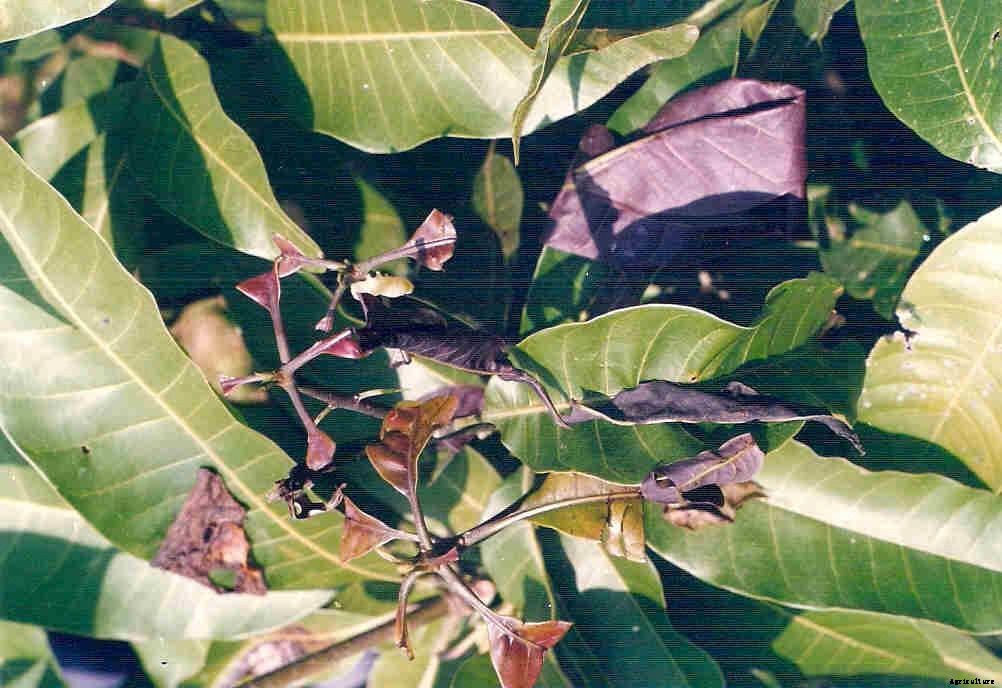
Symptoms:Larvae bore into young tender leaves during August and freshly hatched caterpillar bore into mid rib. After a couple of days, they bore into tender shoots near the growing point tunneling downward, throwing their excreta resulting in dropping of leaves and wilting of terminal shoots.
Gestão
- Attacked shoots should be clipped off and destroyed.
- Spray cabaryl or quinalphos (0.05%) at fortnightly interval from the commencement of new flush.
Bark-eating caterpillar
Symptoms:The caterpillar spins brown zig-zag ribbon-like silken web on tree which consists of their excreta and wood particles. Larvae also make shelter tunnels inside where they rest.
Gestão
- Keep orchard clean and healthy.
- Clean hole and put emulsion of quinalphos (0.05%) in each hole and plug them with mud.
Scale
Symptoms:The nymphs and adult scale suck the sap of leaves and other tender parts reducing vigor of plants. They also excrete honeydew which helps in the development of sooty mould on leaves and other tender parts.
Gestão
- Prune heavily infested plant parts to open the tree canopy and destroy’ them immediately.
- Spray dimethoate (0.06%) at 21 days interval.
- Removal of attendant ants may permit natural enemies to control the insect.
Thrips:
Symptoms:Nymphs and adults lacerate the tissues and suck the oozing cell sap. C. indicus and R. cruentatus feed on leaves and S. dorsalis on in florescence, and young fruits.Leaf feeding species feed on mesophyll near leaf tips.Affected leaves show silvery sheen and bear small spots of faecal matter.
Gestão
If the infestation is severe, can be controlled by either dimethoate (0.1.5%) or Monocrotophos (0.1%)
Tea Mosquito bug:
Symptoms:Major pest of cashew, occasionally damages mango and other fruit crops. Adult is a reddish brown bug with black head, red thorax, and black and white abdomen. Eggs are inserted into epidermis of tender shoots and axis of inflorescence. Adult and nymphs feed on petioles, tender shoots and leaf veins causing necrotic lesions.
Gestão
Spray Dimethoate (0.05) or quinalphos (25 EC) 2 ml/ liter.
Fruit borer:
Symptoms:A major pest in Orissa, West Bengal and Coastal Andhra Pradesh. Pest is active from January to May Adults lay eggs on fruits. After hatching larvae bore into fruits. Fully grown caterpillars (25 mm) have red bands on body alternating with white bands caterpillars bore into the fruit at the bottom (beak region) and feed inside reaching Kernels. Entrance hole is plugged with excreta. Affected fruits rot and fall prematurely.
Gestão
- Collection of fruits and dead wood after fruit harvest.
- Destroy all fallen fruits.
- Spray fenthion (0.1%) at marble size onwards and repeat with Deltamethrin 28 EC @ 1ml/l after two weeks in case of heavy infection
- No spray should be given in fortnight before harvest.
Leaf miner:
Symptoms:Tiny caterpillars mine under the dorsal epidemics of tender leaves and feed within as a result grayish white blisters appear on leaves.
Gestão
- Clipped off destroy the affected shoots.
- Spray quinalphos (0.05%) or fenthion (0.1%) from the emergence of new flush.
Red tree ant
Symptoms:The ants web and stitch together a few leaves, usually at the top of the branches and build their nests. The ants are carnivorous and prey upon small insects. Contudo, indirect damage is caused by protecting insects like aphids and scales, which excrete honey dew.
Gestão
- Nests should be removed and destroyed mechanically by web cutting device.
- Spraying any contact insecticides, Dimethoate 1.5 ml/l after disturbing the nest.
Inflorescence caterpillars
Symptoms:The caterpillars attack inflorescence and if not controlled cause heavy loss through reduced fruit bearing.
Gestão
For efficient management spray Monocrotophos or Dimethoate1ml/l at early panicle emergence.
Termites
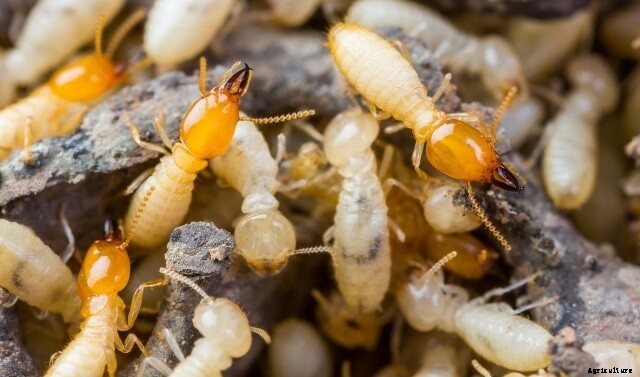
Symptoms:Termites are white in colour, shy to light and remain underground. They feed on root or move upward making the tunnels. They construct mud galleries on tree trunk and under the protection of these galleries; they feed on the bark of the trunks.
Gestão
Remove the mud galleries on trunk and swab or spray the trunk with Malathion (1.5 ml/l).
After two month, drench the soil at the base of the tree with chlorpyriphos 1.5 ml/l.
DISEASES
Oídio
Symptoms:Pathogen attacks the inflorescence, sai, stalk of inflorescence and young fruits with white superficial powdery growth of fungus resulting in its shedding. The sepals are relatively more susceptible than petals. The affected flowers fail to open and may fall prematurely (Fig 28). Dropping of unfertilized infected flowers leads to serious crop loss. Initially young fruits are covered entirely by the mildew. When fruit grows further, epidermis of the infected fruits cracks and corky tissues are formed. Fruits may remain on the tree until they reach up to marble size and then they drop prematurely.
Necrotic lesions on shoulder
Mildew on Lower Surface of and dropping from stalk end Leaf
Infection is noticed on young leaves, when their colour changes from brown to light green. Young leaves are attacked on both the sides but it is more conspicuous on the grower surface. Often these patches coalesce and occupy larger areas turning into purplish brown in colour. The pathogen is restricted to the area of the central and lateral veins of the infected leaf and often twists, curl and get distorted.
Reason for severity
- High humidity, cludy weather &high wind velocity for 3-4 day.
- Minimum temperature (10-130 C), maximum 27-31 0 C and RH 82-91% are most conducive for disease severity.
- Third and fourth week of March attains maximum severity in UP plains.
- Lack of timely fungicidal Schedule.
- Close planting without canopy management.
Mode of Spread
- Spread is dependent on development of mildew pathogen persist on older leaves/ malformed panicles during off season.
- Disease spread through wind borne spores released between 1100 to 1600 hour, which takes 5-7 hours for infection after germination.
Gestão
- Prune diseased leaves and malformed panicles harbouring the pathogen to reduce primary inoculum load.
- Spray wettable sulphur (0.2%) when panicles are 3-4 in size.
- Spray dinocap (0.1%) 15-20 days after first spray.
- Spray tridemorph (0.1%) 15-20 days after second spray.
- Spraying at full bloom needs to be avoided.
Antracnose
Symptoms:The pathogen causes leaf spot/leaf blight, wither tip, blossom blight and fruit rots. On leaves characteristic symptoms appear as oval or irregular vinaceous brown to deep brown spots of various sizes scattered all over the leaf surface. Later lesions get blighted and rupture and show, shot hole symptom
Blossom blight phase
Typical Anthracnose on cultivar
Young leaves are more prone to attack, than older ones. Petiole, when affected, turns grey or black. Disease also produces elongated black necrotic areas on twigs. The tips of young branches start drying from tip downwards. On blossom small black spots appear on panicles and open flowers, which gradually enlarge and coalesce to cause death of flowers. The infected flowers fall-off, leaving more persistent spikes on peduncles.On fruits, it is more common during transit and storage
Reason for severity
- Closer spacing for not doing pruning
- Due to lack of regular spraying against the disease
- Due to negligence of orchard hygene.
Mode of Spread:
- Disease spread by rain splash, spores infect all above healthy tissues on the host.
- Fungus also produces spores on dead twigs, leaves inflorescence and fruits which further make the disease more complex.
- Free moisture available in the orchard enhances disease spread.
- Pathogen remained viable for 14 months on fallen leaves, dead stem and diseased twigs attached to trees.
- Temperature , 25-30 95%;Relative &humidity for 12 hours is conducive for development of disease.
- Movement of planting material / fruits containing infected foliage / fruits..
Gestão
- Diseased leaves, galhos, gall midge infected leaves and fruits, should be collected and burnt.
- Blossom infection can be controlled effectively by spraying of Bavistin (0.1%) at 15 days interval.
- The foliar infection can be controlled by spraying of copper oxychloride (0.3%)
- Pre-harvest sprays of hexaconazole (0.01%) or Carbendazim (0.1%) at 15 days interval should be done in such a way that the last spray falls 15 days prior to harvest.
- Hot water treatment at 520, 10C for 20 minutes. The duration can be reduced to 10 minutes by supplementing Carbendazim or prochloraz both (0.05%) in hot water.
- Covering the fruits on tree, 15 days prior to harvest with news or brown paper bags.
- Use bio control agent viz Streptosporangium pseudovulgare .
Die back
Symptoms:The pathogen causing dieback, tip dieback, graft union blight, twig blight, seedling rot, wood stain, stem-end rot, black root rot, fruit rot, dry rot, brown rot of panicle etc. The disease is most conspicuous during October November. It is characterized by drying back of twigs from top downwards, particularly in older trees followed by drying of leaves which gives an appearance of fire scorch (Fig.36 &Fig. 38). Internal browning in wood tissue is observed when it is slit open along with the long axis. Cracks appear on branches and gum exudes before they die out. When graft union of nursery plant is affected, it usually dies.
Mode of spread
- By planting material containing diseased foliage.
- Disease twigs bearing fruiting bodies are the main source for perpetuation andspread for the next season.
- By using infected budsticks to new areas.
- By inoculums already present in the orchard
- By contaminated garden tools.
Reason for Severity
- Lack of timely control of stem borer which helps in making the tree more prone to disease development.
- Lack of proper cultural operation, viz. pruning of disease twig and application of paste around tree trunk.
- Due to lack of application of copper around the tree trunk in sandy soil.
- Tree damaged by gummosis, insetos, drought and lack of nutrition favour the disease development.
- High summer temperature predispose the plant to the attack of pathogen through reducing the vitality of the plant.
Spread of disease
- By planting material containing disease on stem/leaves.
- Disease twigs bearing fruiting bodies are the main source for perpetuation and spread for the next season.
- By using infected budsticks to new areas.
- By inoculums already present in the orchard
- By contaminated garden tools.
Gestão
- Scion wood selected for propagation should be free from infection
- Every care should be taken to prevent introduction of disease in newly planted orchards.
- Any infected portion should immediately be pruned, followed by spraying/ pasting of copper oxychloride(0.3 %) or pasting with cow dung at the cut ends.
- Pruning should be done in such a way that some healthy portion is also removed, to ensure complete eradication of pathogen (3 “below the infection site).
- The affected branches should be collected and burnt.
Sooty Mould
Symptoms:It is very common wherever honey dew secreting insects, viz. mango hopper, escalas, coccids and mealy bugs are found. Black velvety thin membranous covering on leaves, stems and fruits are its symptoms. In severe cases, trees appear black and look ugly.
Mode of Spread:
- Disease spreads by insect execrating honey dew or sugary substances.
- Growth of fungus is associated with the infestation of scale insects.
Reason for high severity
- Closer spacing where light penetration is low.
- High humidity flavors the development of honey dew insects and disease development.
- Lack of timely control of honeydew exerting insects
- Disease incidence is associated with insect severity.
Gestão
- If honey dew secreting insects are controlled by suitable insecticides, the mould dies out for want of a suitable growth medium. Spraying of monocrotophos (0.05%) at 10-15 days intervals is quite effective.
- Spraying of starch @2% is effective.
- Spray wettable sulphur +monocrotophos +gum acacia (0.2+0.05+0.3%) or Indian oil formulation No. 1 , 2 (4%) at 15 days interval.
- Application of pesticides should cover both sides of leaf.
Phoma blight
Symptoms:The disease is noticed on matured / old leaves only. Fully developed spots are characterized by dark margin and dull grey necrotic centre. In severe cases, spots coalesce to form patches, which result in withering and defoliation of infected leaves .
Gestão
- Spray copper oxychloride (0.3%).
- Balanced nutrition provides resistance to phoma blight.
Bacterial canker disease
Symptoms:The disease is noticed on leaves, leaf stalks, caules, galhos, branches and fruits, initially producing water soaked lesions, later turning into typical canker. On leaves, water soaked irregular satellite to angular raised lesions measuring 1-4 mm in diameter are formed. These lesions are light yellow in colour, initially with yellow halo but with age enlarge or coalesce to form irregular necrotic cankerous patches with dark brown colour.
Infection on Leaf Stalks
On fruits, water-soaked, dark brown to black coloured lesions are observed which gradually developed into cankerous, raised or flat spots. These spots grow bigger usually up to 1 to 5 mm in diameter, which covers / almost the whole fruit. These spots often, burst extruding gummy substances containing highly contagious bacterial cells.
Mode of spread:
- Long distance spread is through planting material and infected mango stones.
- In orchard, wind splashed rains
- By collateral host (Weeds), and high wind velocity favours the spread of disease
- Infection is enhance when rains occur in concert with wind which promote wounding of leaf surface.
Reason for high severity:
- Growing of susceptible varieties in and around orchard
- Disease development is favoured by high humidity (90% RH), moderate temperatures (25-300 C ), high wind velocity is congenial for severity of disease
- Lack of wind breaks to reduce wounding and removal of symptomatic portion of trees to reduce inoculums in the orchard.
- Lack of removal of collateral hosts in the area.
Gestão
- Regular inspection orchards sanitation seedling certification are recommended as preventive measures.
- Mango stones for raising seedlings (root stock) should always be taken from healthy fruits.
- Use wind-breaks helps in reducing brushing/ wounding and thus reduces chance of infection.
- Three sprays of Streptocycline (200ppm) at 10 days intervals reduce fruit infection.
- In severe infection, spraying of Streptocycline (300 ppm) or copper oxychloride (0.3%) is more effective.
- An antagonistic phytoplane bacterium, Bacillus coagulans , is found effective.
Malformation

Symptoms:Vegetative malformation is pronounced in young seedlings. The affected seedlings develop vegetative growths which are abnormal growth, swollen and have very short internodes.
Floral malformation:The flower buds are transformed into vegetative buds and a large number of small leaves and stems, which are characterized by appreciably reduced internodes and give an appearance of witches broom. The flower buds seldom open and remain dull green.
Gestão
- The floral malformed panicles/ vegetative malformed shoots should be pruned and burnt which reduces the incidence of malformation.
- Application of NAA (200 ppm) or planofix (90 ml/ 20 l) in the first week of October (Before bud differentiation stages) followed by deblossoming in the late December or January or bud burst stage reduces the incidence of malformation.
- Spray chelated Zn++(100 ppm) and Cu++(40 ppm) during flower bud differentiation and flowering stage combined with spray of carbendazim (0.1%) during November- December.
Gummosis
Symptoms:The disease is characterized by the presence of profuse oozing of gum on the surface of the affected wood, bark of the trunk and also on larger braches but more common on the cracked branches. In severe cases, droplets of gum trickle down on stem, bark turn dark brown with longitudinal cracks, rots completely and the tree dries up because of cracking, rotting and girdling effects.
Gestão
- The diseased bark / portion should be removed or cleaned and pasted with Bordeaux paste or copper oxychloride paste or cow dung paste or cow dung paste .
- Application of Copper sulphate 500 gm/ tree (depending upon the age of the tree) in soil around the tree trunk is recommended. Gummosis is very less in the orchards receiving regular copper oxychloride sprays for control of leaf spot diseases.
Scab

Symptoms:The scab fungus attack leaves, panicles, blossoms, galhos, bark of stems and mango fruits. Spots are circular, slightly angular, elongated, 2-4 mm in diameter, brown but during rainy season, lesions differ in size, shape and colour. Symptoms produced by the disease are very much like those of anthracnose. On young fruits, the infection is grey to grayish brown with dark irregular margins. As the fruit attains in size, spots also enlarge and the centre may become covered with the crack fissure and corky tissues.
Gestão
- Frequent sprays of copper oxycholoride (0.3%) to protect new flushes of growth are effective for scab control in nurseries.
Black Banded
Symptoms:The disease is noticed on the midribs/ veins of the leaves, twigs and branches as black velvety raise fungal out growth in the form of spots which gradually increase insize encircle the trunk limbs branches and twigs. The incidence of disease is very low on the main branches. The disease occasionally spread on the leaves and cause loss. It presents a characteristic and conspicuous black banded appearance and thus considered appropriate to name it as Black banded diseases.
Gestão
- Gunny rubbing on twigs/ branches to remove the black growth.
- Spraying of Bordeaux mixture (5:5:50) or copper oxychloride (0.3%).
Symptoms:The leaves of affected tree area lusterless and sparse. Diseased tree wilts and dies. Infected roots are very light in weight and get easily crumbled and powdered with fingers. The fruiting bodies of the fungus (brackets) appear at the base of the tree in rainy season.
Root Rot Damping off

Symptoms:The disease is characterized by sudden dropping of leaves after the emergence of seedlings from the soil. During prolonged rainy and humid weather, infection occurs at / or below the ground level with circular to irregular water soaked patches. These patches enlarge and ultimately girdle the entire base of the seedlings.
Gestão
- Care should be taken that water should not stagnate near the root zone.
- Nursery should be raised on elevated beds.
- Nursery beds should be fumigated before sowing.
- Application of Trichoderma in the affected nursery is effective.
- Durante a estação de crescimento, Bordeaux mixture (1.5%) should be sprayed on the plants and the soil at weekly intervals.
Red rust
Symptoms:The disease is readily recognized by the presence of the rusty red fructification of the alga on the surface of the leaves, veins, petiole and young twigs and fruit. Initially the spots are greenish grey in colour and velvety in texture which finally turn into reddish brown in colour.
Gestão
- If vigour of plant is maintained by balanced nutrients, the disease is less.
- Spray Bordeaux mixture (5:5:50) or copper oxychloride (0.3%).
- As the disease starts on the onset of rain, it is desired to spray fungicide twice during the month of July/ August at 15 days intervals.
Lichens
Symptoms:Lichens are found on full grown trees of mango, mainly on trunks, branches and twigs in the areas of high humidity, heavy rainfall and poorly managed orchards. It is seen in the form of whitish, pinkish, superficial patches of different shapes on the main trunk, branches, leaves and twigs of the trees.
Gestão
- Field sanitation and balanced nutrition help in checking the disease.
- The lichens can be managed by gunny rubbing followed by spraying the trunk, branches, twigs with commercial caustic soda (1.0%)
POST HARVEST DISEASE
Antracnose

Sintomas
The post harvest infection starts form the field as latent infection. On stored fruits, black spots are produced. Initially the spots are round but later coalesce to form large irregular blotches. As vezes, it covers the entire fruits surface. The spots have large deep cracks in which fungus penetrates deep into the fruit, causing extensive rotting. Under moist conditions, the blackened areas become covered with minute pinkish reproductive bodies of the fungus. Staining, russetting and tear streaking, involving only the skin of the fruit, are attributed to the same fungus .
Gestão
- The major strategies in controlling post harvest anthracnose are scheduled preharvest sprays with thiophanate methyl or carbendazim (Topsin M OR Bavistin 0.1%) in the field to reduce the latent infection and treatment of the fruits with hot water along or hot water with fungicides after harvest to eradicate the left over latent infection.
- Hot water treatment along at 52 + (-) C for 3 minutes gives good control of anthracnose. Contudo, the duration of hot water treatment can be reduced to 15 minutes by supplementing it with fungicides, viz. carbendazim or thiophante methyl (Bavistin or Topsin M 0.05%).
Stem end Rot Symptoms

The disease starts on fruit at the base of the pedicel. A circular brown area develops near the stem end, which gradually starts developing as dark brown to black area towards the lower portion of the fruit and later even cover the entire fruit surface. The rotting is so fast that the entire fruit rots within 2-3 days. The disease may start on fruit from some point other than the stem end, when fruit get bruises. The disease is observed on ripe fruits only.
Gestão
- Pre harvest sprays of carbendazim or thiophanate methyl (Bavistin or Topsin M 0.1%) 15 days before harvesting control the post harvest rot due to stem end rot.
- As the disease starts from the stem end, it is desired that the harvesting along with 5 cm stalk, the disease is checked. If fruits are harvested without stalk, the opening should be closed with wax.
- Disease can be controlled by dipping the fruits in hot water 52 C with 0.05% cabendazim for five minutes.
Black Rot
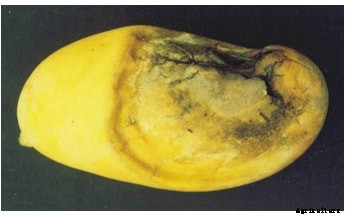
Sintomas
Affected fruits show characteristic yellowing with irregular dull grayish spots, which develop into the black necrotic area with growth of black mould. Tissue below and around the spots disintegrate and emit foul dour. The fruits rot very fast. The rotting may; start from any point but injury is essential for the start of rot. It may also start form the stem end as there remains natural opening.
Gestão
- It is desired that the harvesting of fruits is done carefully as any injury to fruit predisposes it to the attack of Aspergillus rot.
- Fruits should not be allowed to touch soil.
- Fruit harvesting and handling should be done carefully in clean manner.
- Diseases can be controlled by dipping fruits in hot water 5210 C with 0.05% cabendazim for five minutes.
USEFUL TIPS FOR MINIMIZING POST HARVEST DISEASES
- Start controlling post harvest diseases before harvest.
Reason:Many post harvest diseases begin while the crop is still in the field. Some harvested fruits carry latent infection that may not be detected at harvest level.
- Avoid injuring the commodity throughout the entire distribution process from harvesting to marketing.
Reason:Bruises, wounds and other mechanical injuries serve as portal of entry for microorganisms.
- Clean the commodity of soil and other sources of infection after harvest.
Reason:These may carry the microorganisms from the field.
- Keep the fruits dry after washing.
Reason:Free moisture on the fruits surface enhances the growth of spores.
- Separate ripe from unripe fruits either in the containers or storage rooms. Reason:Ripefruits serve source of inoculums (decay-causing microorganisms).
- Handle the fruits carefully during harvesting, sorting, packaging and storing.Reason:Careless handling may bruise the fruits, portanto, providing entry points for disease-causing microorganisms.
- Separate diseased commodities from healthy ones.
Reason:Diseased commodities may contaminate healthy fruit when they come in contact with diseased ones.
- Store commodities at the recommended temperature.
Reason:Disease-causing microorganisms do not grow at low temperatures. Growth will resume upon transfer of commodity to room temperature.
- Provide aeration in storage areas and keep the commodity free of excess moisture.
Reason:Moist conditions favour the growth and multiplication of disease- causing microorganisms.
- Practice sanitation and cleanliness at all times in transit, storage areas, containers and market stalls.
Reason:Dirty and unsanitary containers and areas may serve as sources of infection.
Black Tip
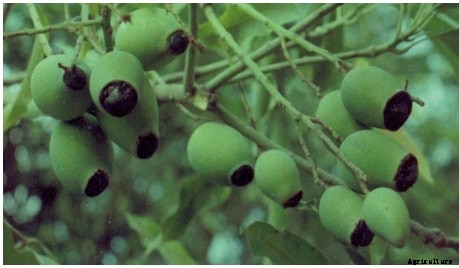
Symptoms:Symptoms become visible when the mango fruits attain some size. Small etiolated area develops near the distal end of the fruit which gradually spreads, turns nearly black and covers the tip of the fruit completely. The black area remains hard and the growth of the fruit is checked.
Black Tip on cultivar Dushehri Reason for high severity:
- Proximity of orchard-to brick kilns.
- Deleterious effect of gases from brick kilns operating in the vicinity of orchard.
- Wind direction (western winds) and velocity play important role in severity
- Lack of timely control measures.
Mode of Spread
Through toxic gas viz. Sulphurdioxide, ethylene, carbonmonooxide and fluoride emitting from brick klins operating nearby orchard.
Gestão
- It can be can be minimized by the spray of borax (1%) or other alkaline solution like caustic soda and washing soda. The first spray should be done positively at pea stage followed by two more sprays at 15 days interval.
- Planting of mango orchard in north-south direction and 3 km away from the brick kilns reduce the incidence.
Internal Necrosis (Boron deficiency)
Symptoms:First, water soaked grayish spots develop on the lower side of the fruit. Late, the spots enlarge and develop into dark brown necrotic area. The internal tissue starts disintegrating. The pericarp and mesocarp is disintegrated exposing the flesh.
Yellow coloured droplets also come out and such affected fruits drop easily.
Internal Necrosis on hanging fruits and close up Management
- Foliar spay of borax (1%) at pea stage followed by two more sprays at 15 days interval.
- Application of 250 gm boron per tree (10-15 year old) around the tree basin.
Fruit Clustering
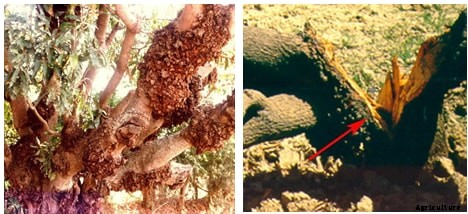
Symptoms:This abnormality is characterized by formation of several fruit lets at the tip of panicle. The fruitlets are darker green in colour and their shape is slightly curved than the normal fruits. These fruits generally hang for more time compared to some normal fruits, which subsequently drop due to other fruit drop reasons. However these fruitless do not grow more and later drop. The fruits do not have formation of seeds.
Gestão
- During flower opening or pollination stages spray of insecticides and fungicides should be avoided.
- Population of pollinators should be kept more during flowering season.
- Pollinizing cultivars should be planted in the orchard.
- Increase pollinator population by keeping bee hives in the orchards.
Woody Stem gall

Symptoms:Woody galls of 10-15 inches diameter are formed on limbs and branches. The galls are abundant on CVS. Chinnasuvarnarekha, Langra and moderate in Neelam.
Gestão
- Remedy lies in removal of galls using saw and applying Bordeaux paste to cut surface.
Red nose / soft nose (Cause not known)
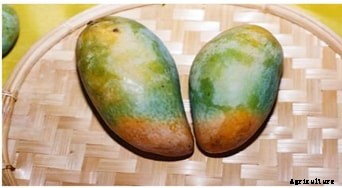
Symptoms:The malady is severe in late maturing Neelam and Mallika varieties particularly in delayed harvest leading to substantial loss. The fruits with red nose are unfit for export. Numerous red nosed fruits are seen on tree during fag end of summer with onset of showers. Red nose gradually becomes soft and rot.
Gestão
- Timely harvesting of fruit.
- Proper nutrition to the plant.
Fruit tumors
Symptoms:Tumors of pea to marble size develop on fruit and are very ugly to look at. The stylar end part is much affected while stem end is practically free from tumors
Fruit showing tumors Management
- Removal of affected fruits from the tree and buried in the soil.
Softening of tissue
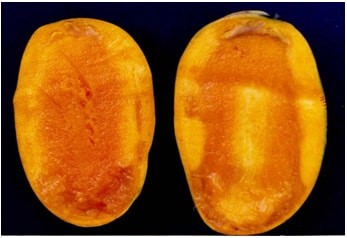
The problem of jelly seed have been recorded in several mango varieties. Contudo, Dashehari cultivar of mango is found more susceptible to this disorder as compared to other cultivars like Chausa and Langra. In this disorder, the pulp near the stone becomes jelly like with tissue disintegration while the outer pulp near the peel is normal. The taste of fruit becomes repulsive and loose table quality. From the outer appearance fruits look normal. It incidence is more in Lucknow region particularly in late harvested fruits (Fig. 74).
Most of the prone orchards of this disorder have been found with imbalance of nutrients. Among the nutrients, P and Zn deficiency were more prevalent. Slow movement of nutrients particularly Ca++ to the fruits from soil and leaf through transpiration stream in Dashehari at maturity was found to be one of the reasons for this disorder.
Gestão
- An integrated approach is found effective for the control the softening of tissue. This includes application of black plastic mulch (100 u thick) in the basin of tree during the month of October- November and foliar spray of calcium chloride dehydrate (2.%) and potassium sulphate (1%), one month before harvesting of fruits along with application of 250 g Borax per tree in soil during the month of November.
- It is desirable to harvest fruits at proper maturity (not late) and make it to ripe in storage rather than to allow on plants.
Spongy tissue
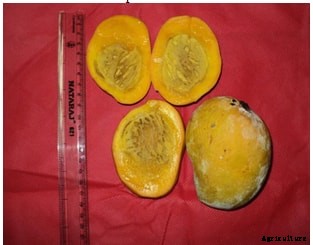
Alphonso mango, which is the main export cultivar, suffers from a serious malady known as spongy tissue or internal breakdown in the ripe fruits. This disorder renders the fruit unfit for consumption and hence, it has become a bottleneck in export and expansion of its cultivation in the State of Maharashtra and Gujarat where it is grown commercially. There are many biochemical changes associate with spongy tissue; Contudo, no conclusive results have been obtained to control this malady. Convicting heat arising from soil and intense solar radiation are reported to be the main cause for this disorder.
Gestão
- Mulching with paddy straw and dry leaves was found effective for its control.
NUTRITIONAL DISORDERS
Potassium deficiency
Symptoms:Scorching of leaf margins is the characteristic symptom of potassium deficiency. Scorching starts from tip downwards. Fruit quality is reduced. Trees with potassium deficiency are easily prone to pest and disease attack.
Scorched Leaf Margin
Gestão
- Application of 1 kg muriate of potash or sulphate of potash along with 2 kg urea and 6 kg super phosphate during July-August in the basin could rectify potassium deficiency.
- Dropped leaves should also be incorporated along with manures to enrich the soil health and fertility.
Zinc deficiency
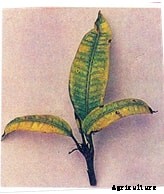
Symptoms:The leaves become small and narrow with leaf margins bent upward or downward. Inter nodal length is reduced drastically and the twig with crowded leaves gives rosette appearance. Pale inferential areas and green veins are typical of zinc deficient leaves. The tree with zinc hunger does not grow well and the yield, size and quality of the fruit are reduced. Small plants with severe zinc deficiency may die. Zinc deficiency is conspicuously seen in alkaline, saline and sandy soils.
Deficiency Symptoms of Zinc
Gestão
- Zinc deficiency can be rectified by spraying of zinc sulphate 5 g +10g urea /1 water twice at 15 days interval.
Iron deficiency
Symptoms:The leaves loose green colour and turn white and is called Bleaching. The size of the leaf is reduced. In severe cases of iron deficiency, the leaves dry from tip downwards. The deficiency is common in soils with high calcium content. Portanto, the effect is known as calcium induced iron chlorosis.
Gestão
- Two sprays at fortnight interval with ferrous sulphate 2.5 g per liter.
Boron deficiency
Symptoms:Cracking of fruit is the characteristic symptom of boron deficiency. Lusterless leathery leaves with thickened veins are the other associated symptoms. Brown areas in yellow fruit pulp are conspicuous.
Gestão
- Application of 250gm boron per tree (10-15 year old) with recommended dose of manures during July-August.
Salt injury / Toxicity
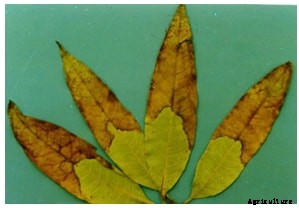
Symptoms:The leaves are scorched due to excess salt in soil or irrigation water. The leaves lose their natural colour and turn to bronze colour. Tip burning is also seen in severe cases of salt injury.
Management:
- Raise Dhiancha as green manure crop with onset of monsoon in the inter-spaces of the orchard during tree bearing years and remove.
- Farm yard manure and compost should be applied adequately every year.
- Gypsum filled gunny bag if kept in flowing irrigation water will reduce salt effect.
Copper deficiency
Symptoms:Copper deficiency symptoms frequently develop on young trees which generally occur due to heavy nitrogenous fertilization. It may also be accompanied by Zinc deficiency symptoms. The appearance of weak terminal shoots followed by defoliation and die back of branches, on the top of long drooping or shaped branches of the proceeding cycle of growth usually makes evident that copper is needed
Gestão
- Application / spraying of Copper (250 g/ 10 years tree) or Copper oxychloride (0.3%) at monthly interval.
PEST MONITORING
Survey:To monitor the initial development of pest and disease in the endemic areas survey is prerequisite. Portanto, for field scouting farmers should be mobilized to observe the pest and disease occurrence at the intervals as stipulated under different development stages. The plant protection measures are required to be taken only when bio control potential does not show promise and pest and disease incidences shows increasing trend.
Field Scouting:Field scouting for pests/disease and bio control fauna/flora by extension agencies and farmers once in a fortnight should be undertaken to assess increasing/decreasing trend in the pest/disease incidence and availability of bio control potential. This should be done soon after the appearance of new flush after the fall of old leaves as such stage of the crop having succulent tissues in valuable to attack by pests and diseases. The state Departments of Horticulture should make all possible efforts by using different media, mode and publicity to inform the farmers for field scouting in the specific crop area having indication of pest and disease build up.
Pest Monitoring through Traps:
- Through yellow sticky traps:Setup yellow fast coloured sticky traps for monitoring sucking pests one trap/5 trees. Locally available empty yellow Palmolive-tins coated with grease/ Vaseline/castor oil on outer surface may also be used.
- Sex pheromone traps:These traps are very useful tool in monitoring and control of population of fruit fly. Hanging of traps containing 100 ml of water emulsion of methyl eugenol (0.1%) + malathion (0.1%) during fruiting season (April-July) is very effective for control of fruit fly. Ten traps per hectare of orchard gives satisfactory control. Traps can be fixed during morning hours.
IPM STRATEGIES
Cultural Practices
- Deep ploughing of orchard immediately after harvest to expose eggs and pupae of mealy bug, inflorescence midge and fruit fly.
- Heavy irrigation of orchard in October also helps in destruction of eggs of mealy bug, diapause pupae of midge and fruit fly.
- Avoid dense planting, keep orchard clean by regular ploughing, removal or weeds and prune the over crowded and overlapping branches in December for control of hoppers.
- Raking of soil around the tree trunks and mixing with methyl parathion 2% dust
- 250 g per tree for controlling early instars nymphs of mealy bugs in t he month of November-December.
- Collection and destruction of stone weevil infested fallen fruits and stones help in reduction and carry over of infestation.
Mechanical Control
- After mud plastering 25 cm wide, 400 gauge alkathene (Polythene) sheet should be fastened to the tree \trunk with the help of sutili, about 30 cm above the ground level to prevent migration of freshly hatched first instar nymphs of mealy bugs in the month of November-December.
- Early harvesting of mature fruits to avoid fruitfly infestation, collection and destruction of fruit fly infested fruits.
- Removal of webs made by leaf webber by leaf removing device and burning them in August to September to control leaf webber.
- Pruning of overcrowded and overlapping branches for control of leaf webber dried portion and pasting of copper oxychloride for control of dieback disease.
- Diseased foliage / twig infected with anthracnose disease should be pruned during these months.
- Removal of powdery mildew infected leaves and malformed panicles in April.
Biological Control
A large number of parasites, predator and pathogens are very active against pests of mango in the fields. Estes são Rodolia fumida, Suminus renardi, Coccinellids, Beauveria bassiana, Verticillium lacani, Mallada boninensis, Chrysopa spp., Tertrastichus spp., Trichoderma spp., Gonatocerus spp, Podynema spp., Platygaster sp, Eupulmus sp., Systasis dasynearue, Micronimus timidis, Baccha pulchrifrons, etc . which pay a significant role in population suppression of various insect pests and diseases. These should be conserved in the field.
Chemical Control
Chemical pesticides recommended for control of diseases and pests are given in the text.
SOME USEFUL TIPS IN PEST MANGEMENT
- Always use protective clothing while spraying.
- Avoid spraying insecticides repeatedly. Alternate them with botanicals, wherever possible to prevent development of resistance and pest resurgence.
- Add 0.5 ml of any sticking agent to the spray solution.
- Oil should be made into an emulsion before spray by shaking thoroughly in a bottle before dilution and sprayed immediately without any delay.
- Botanicals may cause phytoxicity when the temperature is more than 32 0 C in polyhouse. Hence it should be done with caution and only after pre-checking.It is always better to spray botanicals in the evening.
- After spraying any insecticide keep appropriate waiting period before harvesting fruits.
- Preparation of neem seed powder extract 4%:Soak 4 kg of pulverized neem seed powder in 20 litres of water overnight or 12 ha. Depois disso, filter through a fine cloth or double layered nylon net and make to 100 litres and spray. One hectare of the crop requires 1000 litres of spray fluid and 40 kg of neem seed powder.
- Preparation of oil emulsion for spray:When oil is used either alone or mixed with insecticides, the spray fluid should be made into an emulsion. Take required quantity of oil in a plastic bottle, add sticker and required quantity of insecticide (if oil has to be mixed with insecticide), double the quantity of oil, shake thoroughly, transfer to spray tank, dilute with required water and spray immediately.



























